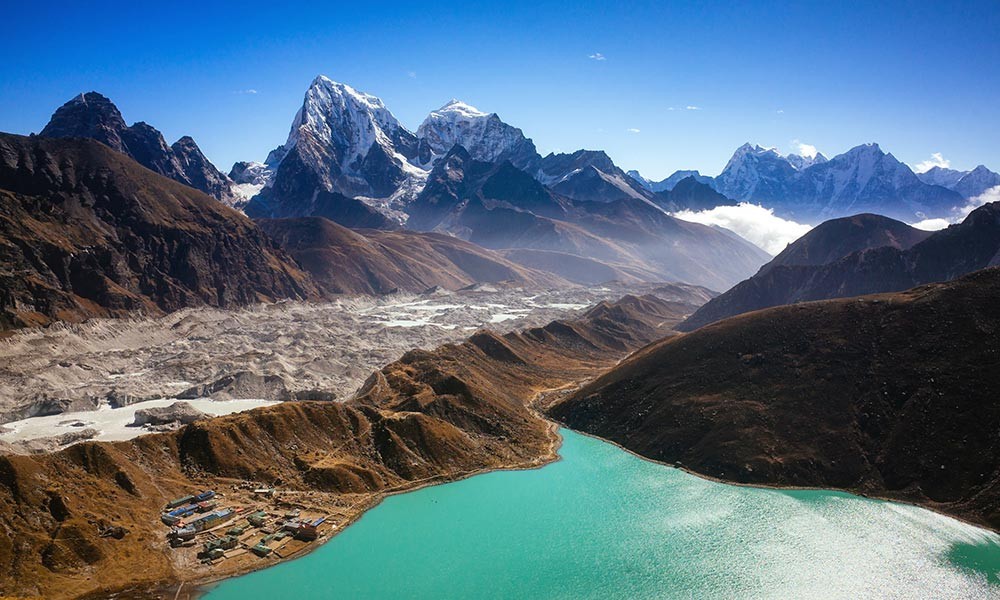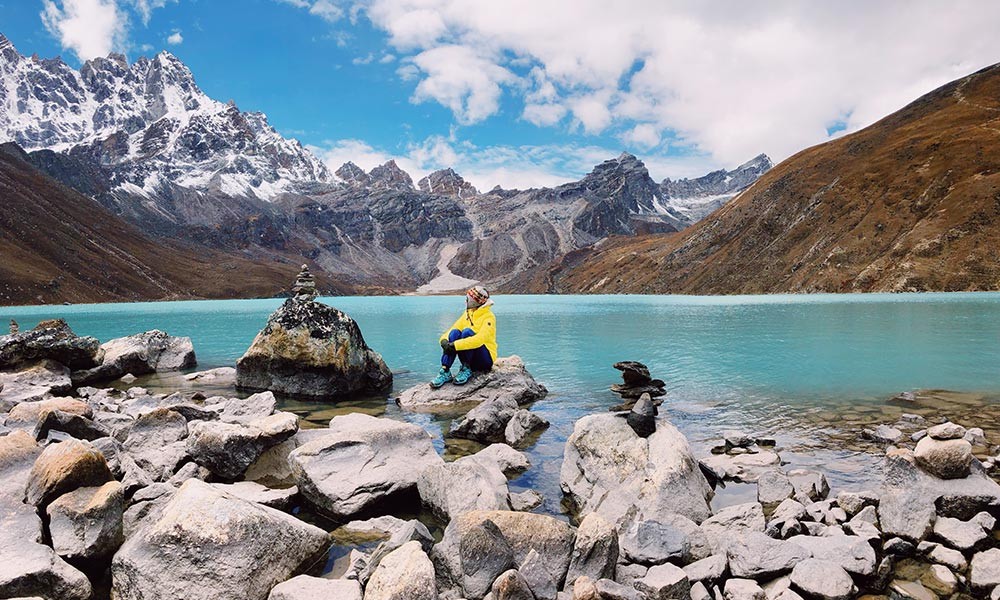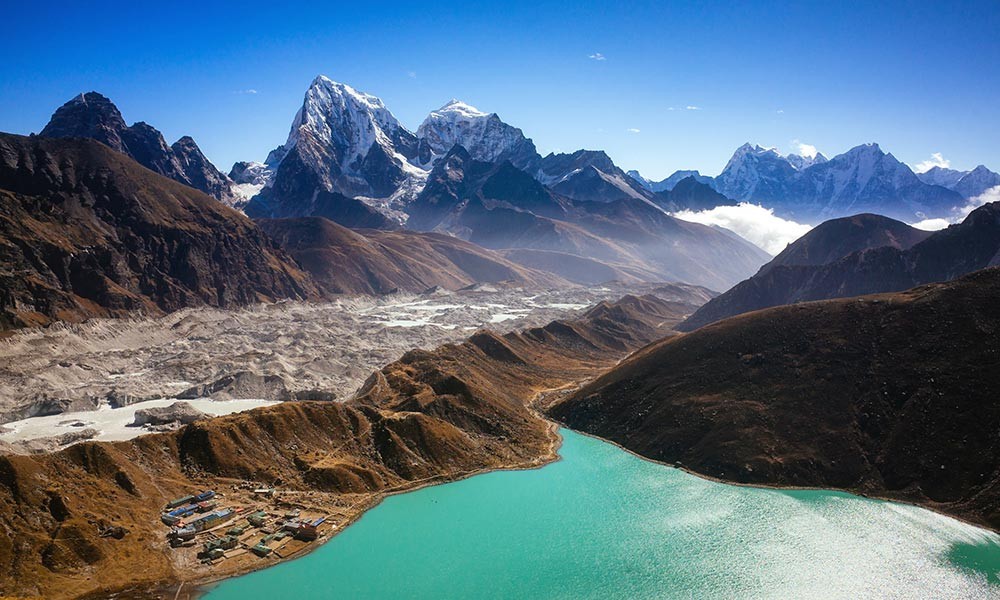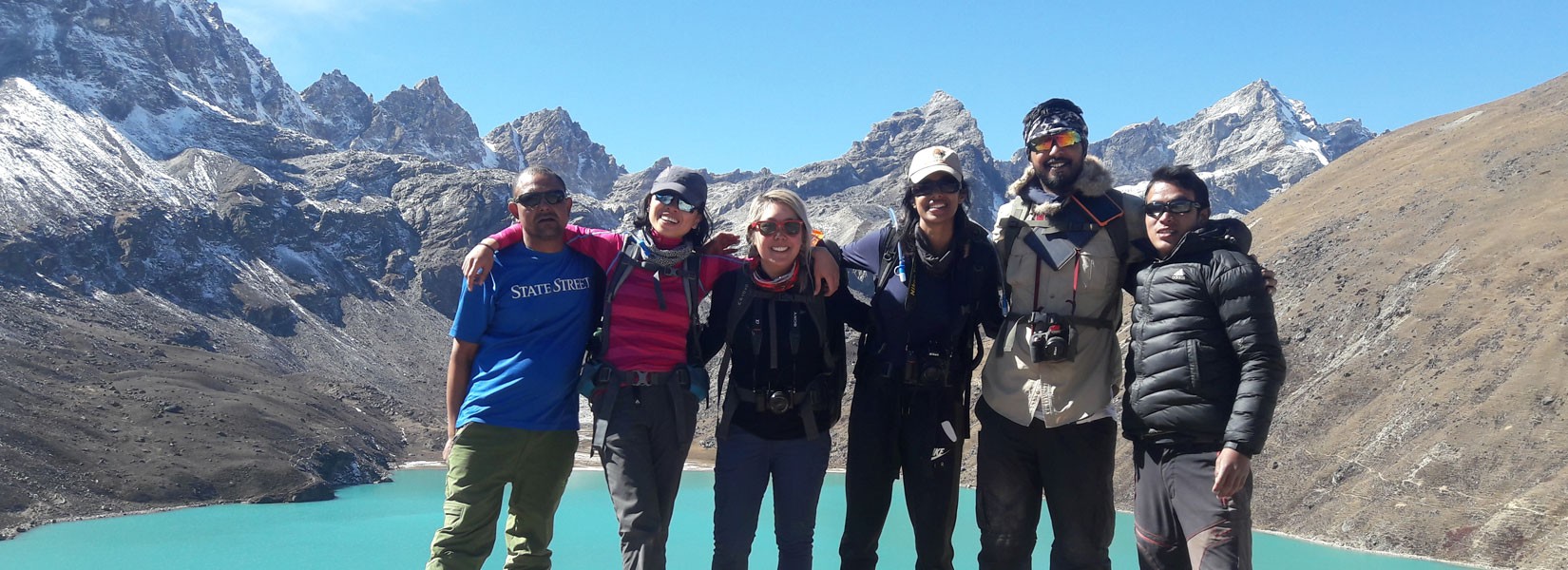Is Insurance Mandatory?
Yes, travel insurance is mandatory and highly recommended. Trekking at high altitudes is always risky. Look for a company that covers the cost of injuries, medical expenses, and helicopter evacuation costs. Helicopter rescue is the only option to take you to the nearest hospital if you get sick at a high altitude.
Do I get Guide and Porter?
Yes, Marvel Adventure provides a well-experienced, fluent English-speaking guide who has sound knowledge of the mountains, history, and local cultures of the region. They guide you throughout the trek as well as entertain you during the walk.
We also provide one porter for two trekkers. Porters can carry 20-25 kg of bags. They will carry your bags so that you can walk easily and enjoy every moment during the trek. We recommend you pack only the essential gear.
Because of their hard effort, guides and porters expect some TIPS from you.

Best time for Gokyo Valley Trek
Autumn Season
Autumn is one of the few times when trekkers will experience warm and pleasant weather. It’s usually dry and sunny in Khumbu during the season. Days are warmer and nights are chillier, with temperatures dropping up to 2 degrees Celsius.
The temperature in Gokyo Lake is much colder, averaging about -12 degrees Celsius. With winter just around, November typically has the coldest days of all autumn months. Trekkers will likely witness a gradual temperature drop along with light snowfall.
The autumn color might have faded over time. But if you walk the trail in October, there’s enough stunning fall foliage along the trek. Visitors can watch the changing tree leaves and lush meadows during the expedition.
Spring Season
Trekkers can experience similar weather in spring as well. Warm days, cooler nights, and fabulous views make the season incredible to hike. It has long daylight hours full of sunshine, which makes the climb easy and comfortable.
But, since winter doesn’t go without putting up a fight, the weather is cold at the beginning of the season. There might be light snowfall in different parts, especially at higher altitudes. After late March, the temperature will increase, but it will still be cold at Gokyo Lake.
There’s low precipitation and humidity in Spring at Gokyo. Meanwhile, flower blooms are at their peak in the valley and forest. Its green terrace farms and colorful wildflowers provide a picturesque backdrop to the hikers.
Also, migrating birds and animals put on an excellent show for them. Since the weather will be warm with clear skies, trekkers can enjoy the unobstructed view of shimmering snow peaks and diverse landscapes.
Off-season
Winter is the off-season for trekking in Nepal. It starts from December and ends in February. During these months, you are less likely to meet the trekkers on the route. The temperature starts dropping, and snowfall is very likely to happen. Those who enjoy snowfall may resist the odds; winter is the best time. But they do it with lots of preparations, as winters could be severe in the mountains, as the days are short and cold. The average temperature of Gokyo is -10 to -14 degrees Celsius in winter, which makes the hike incredibly difficult.
Summer is humid and hot in Khumbu, with an average temperature of 2.3 degrees Celsius. It has warmer days with bright sunshine, making the trek more comfortable.
But it doesn’t last long as the monsoon starts. There might be heavy rainfall from mid-June, which makes the trail murky. The weather might not be clear, and it’s hard to catch the views.
Follow our best time for Gokyo trek guide for detailed information.
Food & Accommodation
Wandering the trails of Gokyo, especially if you want a place to stay, isn’t a competitive spirit. There are ample accommodation options here, including lodges, hotels, and teahouses.
In the valley, guesthouses are the most affordable choices for accommodation.
They are well-equipped and spacious with pre-arranged furniture. Most of the lodgings offer a handful of services like a bed, pillow, blanket, and a hand towel to the guest. They usually charge a low price of around US$2 to US$5 per night.
There’s no shortage of accommodation in higher regions either. You will find lots of teahouses. They have twin-share rooms with sufficient space for each person. Unfortunately, the rooms have no direct connection to the bathroom, so the guests will have to share the regular ones.
Apart from the lodging, they also provide food to the visitors, consisting of local staple foods like rice, lentils, curry, and pickles. It’s a classic Nepali dish, simple yet delicious. Other dishes available to try are fried noodles, tasty dumplings, and pancakes.
The breakfast has soup, bread, muesli, and eggs, typically served with tea. But, these are only offered by the guesthouses in town. There’s usually a shortage of food items in teahouses at higher altitudes.
Due to rugged trails, goods must be transported using porters or yaks, increasing costs. Foods are relatively cheaper in lower valleys, so if you want to save money, stock the goods right here.
Trek Essentials
Trek to Gokyo Lake isn’t a stroll in the park. It’s a strenuous walk of 61 miles with many ups and downs. The trail to this glacial lake has steep hills that go down to the forest and above the valley. Besides, it has unpredictable weather, which makes the trek even more difficult.
Hence, trekking to Gokyo Lake needs good preparation along with some equipment required for the trek. You have to be careful while picking these items and ensure they don’t go to waste. Consideration must be given to weather, trek difficulties, duration, and distance. Here are some of the trek essentials needed for the Gokyo Valley Trek.
Clothing
- Lightweight fleece jacket
- Waterproof jacket
- Short and long-sleeved shirt
- Moisture-wicking t-shirt
- Quick-drying pants or shorts
Footwear
- Hiking boots
- Trekking shoes suited to terrains
- Synthetic or wool socks
Other items
- First-aid kit
- Personal toiletries such as a toothbrush, soap
- Batteries, charger, power bank
- Hand sanitizer
- Insect repellent
- Duffel bags
Preparations for Gokyo Valley Trek
Gokyo Valley Trek is pretty challenging, especially for someone who has never trekked before. It has mixed terrains with some rocky hills, which are physically demanding. The fight against its winding trail isn’t easy to win either. Trekkers have to walk through the lush meadows and valleys before making a continuous ascent to Gokyo Lake.
Hence, it requires some hardcore training to tackle these harsh trails. Trekkers have to give at least a month for physical training. They must be dedicated as the hike is not easy. They should spend as much time as possible on the routine workout, as it helps them stay fit and in good shape.
Walking back and forth on the steep trails is exhausting. So, try doing labor-intensive activity and cardiovascular exercises like running, cycling, jogging, and brisk walking. These workouts will help to improve your muscular strength and endurance capacity.
Taking a few hikes on different routes before the trek is an excellent idea. Not only will they prepare you well for the trek, but they’ll also help you tackle the mountainous terrains. It’ll take the stress off your head and make the walk more accessible.
Mental Preparation
As much as physical exercise is essential, mental toughness is also important. Therefore, trekkers have to take care of their mental strength. Hiking to Gokyo Lake is weight-bearing and mentally exhausting work.
So, put in extra effort on the hike and give yourself enough time to prepare. Don’t be intimidated by the trek difficulties; fight against the odds. Maintain resilience and maximize your abilities as much as possible. Stay hydrated, and don’t let the trek get into your nerves.

Why trek Gokyo Lake?
Stunning Views
Gokyo Lake isn’t short on breathtaking views. Some of its best can be discovered along the trail, while the rest can be traced at the spot. Trekkers can enjoy the natural view of tropical forests, lush green foliage, and beautiful valleys on their journey.
During the hike, they also watch the spectacular view of mountain ranges and lovely waterfalls. At Gokyo, they can find many iconic landmarks, oligotrophic lakes, and glaciers, which are pretty impressive.
Gokyo Lakes
Named after Gokyo Ri peak, the Gokyo Lakes are the attractions of this trek. They are located at an elevation ranging from 4,700m to 5,000m in the Sagarmatha National Park. The Gokyo Lakes are the world’s highest freshwater lakes and comprise six main lakes. There are a total of 19 lakes, though. In this trek, you get to see Gokyo Cho aka Dudh Pokhari, Thonak Cho, Gyazumpa Cho, Tanjung Cho, and Kyajumba Cho. Dudh Pokhari is most frequently visited among all and is an iconic lake in the area. These lakes are sacred to both the Hindus and Buddhists in Nepal.
Magnificent Mountains
The trek takes you along a diverse landscape offering views of a range of mountains from the start. It all begins with an opportunity to witness the magnificence of Ama Dablam (6,812 m). Not to miss are the graceful summits of Thamserku (6,608 m) and Chamlang (7,319 m). The massive Kantega (6,782 m) and the prominent Kongde Ri (6,187 m) are other peaks you can see along the trekking trail. As you ascend, you feel nearing the mountain giants, including the world’s tallest peak, Everest (8,8848m). Alongside, you also catch the views of Lhotse (8,516 m), Makalu (8,481 m), Cho Oyu (8,188 m), Nuptse (7,861 m), Pumori (7,161 m), Island Peak (6,160 m) and Cholatse (6,440 m).
Cultural Exploration
Gokyo Valley Trek is an overwhelming experience for visitors who are new to Nepali culture, language, and tradition. They’ll be acquainted with the local Sherpa culture and their religious ceremonies on this trek.
Visitors will get to blend in with the native people. Just a few days at Khumbu and they’ll be well aware of the Himalayan lifestyle, customs, and practices. Various trails in Khumbu will provide trekkers with a view of Tibetan monasteries, Chortens, and mani walls.
Festive Encounters
Here is a brief overview of some of the major festivals of the region. If you happen to trek in the area during the festive season, you get to enjoy the festive colors along with the locals.
Gyalpo Lhosar
People from Sherpa communities celebrate this festival in February or March, based on their calendar. This celebration marks the beginning of the Tibetan New Year. You will see people performing folk dances, partying, organising ceremonies, as well as sacred practices, as a part of this festival.
Mani Rimdu
If you opt for an autumn trek to the Gokyo Valley, you might get to participate in this festival with the locals. Mani Rimdu is a major festival of the Sherpa people that usually falls in October or November. The 19-day festival features mask dance, fire rites, colorful mandala of sand, meditation and other ceremonies. If you are a cultural enthusiast, you may adjust your trek calendar accordingly and enjoy the festival.
Dumje
The four-day festival is celebrated in May/June. It marks the birth anniversary of Guru Rinpoche. Those following Tibetan Buddhism regard him as a revered figure. Some of the highlights of this festival include performances of dance and different rituals. This is also a major Sherpa festival.
Adventurous Trail
Gokyo Valley Trek is more of a trail walking than exploration. Trekkers will have to do the sightseeing while hiking. This makes the journey more adventurous and fun as they get to view stunning snow peaks, beautiful landscapes, and waterfalls.
As the trailhead starts in the town of Lukla, trekkers will explore a series of villages and walk the lush meadows before heading to the mountain. The voyage offers them some of the finest of Khumbu, including the view of steep-sided valleys, deep forests, and charming towns.
Exploration of rural settlements
The trek to Gokyo Lake allows visitors to explore the rural settlements of Khumbu. It makes them travel through the medieval Sherpa villages and towns. Trekkers can expect to receive warm hospitality and aid. The locals here are incredibly nice and friendly to the guests. They make them feel at home and help them with anything and everything.
Moderate trails
Gokyo Valley Trek has easy hiking trails as compared to other walks. The trek has no technical difficulties except for a few steep hills and rugged trails. The walk on the Ngozumpa Glacier can be slightly challenging and demanding. Walking the long forested trails and climbing up the valley won’t be easier either. But, apart from that, the trek is a breeze with no obstacles.
Difficulties of Gokyo Valley Trek
Walking the most popular hikes in Nepal may seem fun, but it's a lot harder. Traveling through the wilderness and climbing steep slopes for multiple hours is grueling. Its trails are physically demanding, with many twists and turns.
Not just the trail, but even the weather of Gokyo is tricky. It fools visitors into climbing the trail and makes the journey challenging for them. Some of the other difficulties of the Gokyo Valley Trek are as follows.
Trek Distance
The long walking trails of Gokyo Lake require multiple days to finish. Trekkers have to walk an average of 5-6 hours and cover a distance of 10-15 km, which is a lot. The hike is intimidating for any trekker who’s not used to walking the highlands or rocky terrains.
Since the trek has to be completed within the travel limit, trekkers have to beat the clock. In this matter, choosing a short itinerary isn’t going to be much help. Covering longer distances in a short time is inconvenient for any hiker.
Altitude Sickness
Gokyo Valley Trek is a mountain trek. So, the hikers will have to travel at higher altitudes for most of the expedition. As they go higher, the oxygen level decreases and causes altitude sickness. The low atmospheric pressure makes the trekkers dizzy and exhausted. Some of them even have difficulty breathing due to low oxygen.
Dehydration
Walking the mountainous terrains of Gokyo while carrying a heavy daypack can bug anyone. On top of that, you have to climb steep trails and walk in the heat, which causes the body to lose sweat. The overflow of liquid increases the risk of dehydration and fatigue. Trekkers will suffer from terrible headaches, sunken eyes, and listlessness. Therefore, to prevent dehydration, they have to drink sufficient water rather than relying on just a bottle of water.
Weather & Temperature
The unpredictable weather of Gokyo Lake is another challenge for hikers. When hiking, trekkers experience a tremendous change in weather due to the rise in altitude. The weather is usually frigid at Gokyo, but it changes with the season down in the valley. Summers are hot and humid in Khumbu, while winters are chilly, which makes hiking extremely difficult.
Trail Logistics
Electricity, ATM and Internet are some of the basic facilities you have been used to in your daily life. The trekking trail also offers these facilities, but they have some limitations.
Read on to know more about these logistics:
Electricity
You require electricity for charging your phones and camera, among other things. And of course, for lighting purposes. Your accommodation facility arranges the lights for you during your stay there. They have an area for charging in their reception or dining area where you can charge your devices. You may need to pay extra in return for receiving this service.
Internet
There are two options for Internet connections — WiFi and cellular data. You will get good WiFi service up to Namche Bazaar. Your teahouse or lodge may charge you extra if you want to use it there. Meanwhile, you need to get SIM cards of NTC or NCELL, Nepali telecommunication providers, to opt for mobile data. They can have good network coverage, yet are not always reliable.
ATM
There are plenty of ATMs in Kathmandu. But your trekking trail is different. They are available only up to Namche Bazaar. So, you can either withdraw money in Kathmandu or at Namche Bazaar and carry the cash with you.
Hot Showers
Hot showers are available at the accommodation facilities that you find in the Gokyo Valley trek. Yet, you need to remember that at higher altitudes they are limited or even slow to heat. Some include hot water in the lodging services at lower altitudes, but at higher altitudes, you have to pay extra per shower.
FAQs
Is it difficult to trek to Gokyo Valley?
The Gokyo Valley Trek is a moderately difficult endeavor. There are not many technical and difficult segments during this trek. It is an easy trek as compared to the trek to the Everest Base Camp via Cho La Pass or passing through Renjo La Pass.
Do I need to be an experienced trekker for this Trek?
You do not require prior trekking experience. But it is an advantage that you are an experienced trekker. Irrespective of your experiences, you must be prepared to cover a distance of around 10-15 km every day in about 5-6 hours along rocky and rough terrains.
How can I prepare to trek to Gokyo Valley?
Prepare yourself both physically and mentally if you want to be a part of the Gokyo Valley trek. Allow at least a month for physical training. Cardiovascular exercise and labor-intensive activities are required to prepare the body. Be mentally prepared for the long treks, difficult terrains and unexpected circumstances.
How high do I reach during the trek?
You reach the maximum altitude of 5,357m during the Gokyo Valley trek. This is the summit of Gokyo Ri, the highest point of the entire trek.
Should I worry about altitude sickness?
The trek requires you to ascend above 3,000 m. So, there is a risk of altitude sickness. But focus on proper acclimatization to prevent it. For instance, gradual ascents and staying hydrated are some of the precautions. If you show any symptoms of altitude sickness, you need to inform your guide or any other person concerned immediately.
How many days do I need to complete the Gokyo Valley Trek?
We offer a 10-day trek package that begins with a flight to Lukla, all the way from Kathmandu. On the seventh day, you reach the highest point of the trek, Gokyo-Ri. You fly back to Kathmandu on the tenth day from Lukla. It marks the end of your trek.
Is this trek safe?
The trek to Gokyo Valley is safe. To ensure safety, use a reputable agency with licensed guides and porters. They help you along the trek route and are equipped with trek essentials. In the case of an emergency, the trekking agency rescues you via a helicopter.
I do not have travel insurance. Can I trek to Gokyo Valley without it?
Travel insurance is mandatory for those who are looking forward to being a part of the Gokyo Valley trek. Your insurance plan must cover the costs related to your medical and emergency evacuation. This includes helicopter rescue operations.
How do I get the permits required for this trek?
Typically, your trekking agency obtains the necessary permits for you. We, here at Marvel Adventure, help you with this. For the general ideal, you need to obtain the Sagarmatha National Park permit and the Khumbu Pasang Lhamu Rural Municipality permits for this trek.
Is there a weight limit I need to adhere to?
We provide one porter for two trekkers, and each porter carries a maximum of 20-25 kg of bags. So, you should pack your trekking luggage accordingly.
Is drinking water along the trekking trails Safe?
You can drink bottled water on the trails. They are easily available and cheaper too. But you should bring your water bottle and water purification tablets for those areas that do not allow plastic bottles.
Should I bring my sleeping bag during this trek, like in other trekking routes?
The lodges and teahouses along the trek provide blankets and mattresses for their patrons. But if you bring your sleeping bag, you can have a more comfortable sleep at higher altitudes. The temperatures can drop significantly at night. In such cases, the basic blanket provided by the lodges may not be sufficient for you.
Do I Get to See Lakes During the Gokyo Valley Trek?
Yes, the Gokyo Valley Trek is known for its glacial lakes. You will get to see multiple lakes during the trek. In the case of the Gokyo Lakes, they have 19 lakes in the system.
How Can I Book This Trek?
Go through the 'Book Now' button. We require 20% of the total trip cost for booking confirmation. You can make the remaining payment after arriving in Nepal.
What if I Want to Cancel?
Kindly check our cancellation policies.
 When someone says Nepal is a trekker’s paradise, they indeed don’t lie. The country is abundant in natural beauty, which never fades. It has unique topography and remarkable landscapes that are best explored on foot. And during the Gokyo Valley trek, you get to experience these at once.
When someone says Nepal is a trekker’s paradise, they indeed don’t lie. The country is abundant in natural beauty, which never fades. It has unique topography and remarkable landscapes that are best explored on foot. And during the Gokyo Valley trek, you get to experience these at once.









